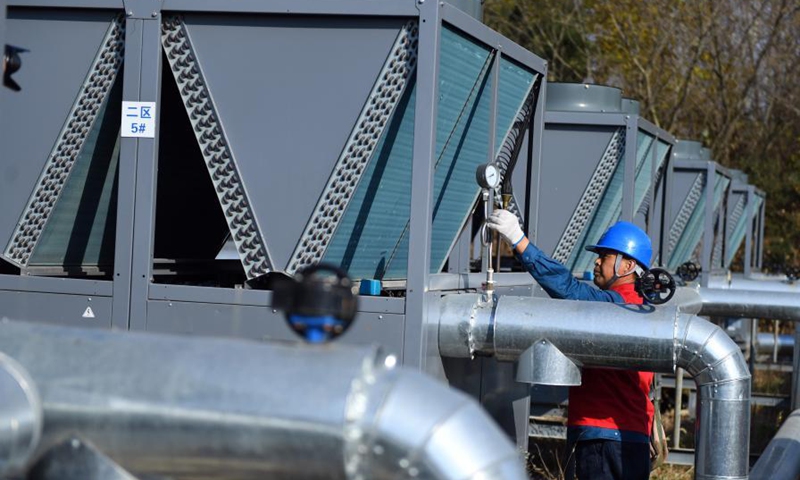Trials of carbon trading in China underpin vision of clean energy consumption
By GT staff reporters Source: Global Times Published: 2020/12/21 21:18:39
Pilot carbon trading programs mapped out for provinces

A technician checks the power supply lines at a heating station with clean energy at Wendeng district in Weihai, east China's Shandong Province, Nov. 12, 2020. Shandong launched a campaign to promote a shift from coal to electricity for 358,400 households during its heating season in 2020, which will save 270,000 tonnes of standard coal and reduce emission of 680,000 tonnes of carbon dioxide in the heating season. (Xinhua/Zhu Zheng)
As part of efforts to push for the transition to a low-carbon economy, China has launched trials of carbon trading in seven designated areas including Beijing, according to a white paper on energy development released on Monday that outlines the country's vision to remake energy consumption.
The trading of energy consumption allowances has also undergone pilot programs in four provinces including East China's Zhejiang Province, read the white paper.
Such trials are seen as contributing to a changing energy production and usage landscape in the world's top energy producer and consumer.
Between 2013 and 2019, China's energy consumption per unit of GDP decreased by a cumulative 24.4 percent, equivalent to a reduction of about 2.7 billion tons of carbon dioxide emissions, Zhang Jianhua, head of the National Energy Administration (NEA), said at a press conference on Monday at the unveiling of the white paper.
It points to an average annual GDP growth rate of 7 percent that was underpinned by an average annual rise of 2.8 percent in energy consumption, according to Zhang.
Clean energy as a percentage of China's energy consumption has hit 23.4 percent, 8.9 percentage points higher than in 2012, the white paper said, and the country's cumulative installed capacities for hydro, wind and solar power all ranked No.1 globally. As a result of green energy development, the nation's carbon emissions intensity was lowered by 48.1 percent in 2019 compared with 2005.
The Chinese leadership's bold pledge to have CO2 emissions peak before 2030 and achieve carbon neutrality by 2060 adds energy structure to emissions-cutting efforts, beefing up calls to go deeper into the carbon trading market.
"Carbon trading is an important means of advancing carbon neutrality in a market-oriented manner as it allows for more efficient and cost-effective emissions," Ma Jun, director of the Institute of Public and Environmental Affairs, told the Global Times on Monday.
Carbon trading enables the purchase and sale of permits and credits for CO2 emissions.
A nationwide carbon market is expected to be up and running next year, and the power generation sector -- as the first major industry to be included into the market -- will rev up the clean and low-carbon shift among power plants, the Economic Information Daily reported on Monday. Steel, chemical and other sectors will be included later.
The national carbon market will eventually cover more than 2,000 firms in the power generation sector and involve tradable quotas of about 4 billion tons, higher than the combined quotas in the EU - 2.8 billon tons, Lai Xiaoming, chairman of the Shanghai Environment and Energy Exchange Corp, the operator of the Shanghai carbon emissions trading exchange, told the Global Times.
The EU's Emissions Trading System is the world's No.1 carbon market, representing roughly 80 percent of trading volumes.
China's national carbon market will be the world's largest by quota size and Shanghai is set to become the largest carbon spot goods trading hub in the world, according to Lai.
The nation's first pilot carbon trading program was launched in Shenzhen in June 2013. Subsequently, experimental trading programs were rolled out in six other designated areas - the cities of Beijing, Tianjin, Shanghai and Chongqing and the provinces of Guangdong and Hubei.
As of August, the pilot trading systems covered nearly 3,000 major industrial emitters, with cumulative trade totaling 406 million tons of CO2 with the equivalent greenhouse gas and transaction cost amounting to 9.28 billion yuan ($1.41 billion) in turnover, Li Gao, head of the climate change department at the Ministry of Ecology and Environment, disclosed in October.
Global emissions trading reached a record high of $214 billion in 2019, Reuters reported in January. Trading levels increased 34 percent year-on-year, the third year in a row of growth.
Still, as Ma pointed out, tremendous efforts are required to ensure sufficient carbon trades and to establish a sound framework for genuinely emissions-reducing trading efforts.
The nation needs to calibrate the total allowances to be traded and carbon quota allocations among emitters for there to be enough trading activities, he suggested, adding that even the EU is bewildered by an overabundance of allocation quotas that lead to low prices and weak trading volume, and consequently affect emissions.
Emitters, for their part, ought to calculate their carbon emissions and fully disclose their involvement in carbon trading, the environmentalist said.
Other than the creation of a national carbon market, there are some other market-based efforts to be carbon neutral, he added, citing Apple's pledge to be carbon neutral by 2030 - a goal that covers itself and its suppliers.
Dozens of major global brands have set carbon neutrality deadlines, a move that has yet to be copied by Chinese businesses, Ma noted, calling for domestic brands to catch up with their global counterparts in building green supply chains.
Chinese tech giant Huawei is at the forefront of the local push for carbon neutrality with its announcement to set carbon emissions reduction targets for its top 100 suppliers by 2025.
Newspaper headline: Nations launching clean-energy drive
Posted in: INDUSTRIES,BIZ FOCUS